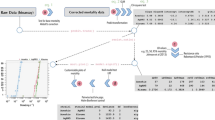Abstract
In the past, arithmetic and geometric means have both been used to characterise pathogen densities in samples used for microbial risk assessment models. The calculation of total (annual) risk is based on cumulative independent (daily) exposures and the use of an exponential dose–response model, such as that used for exposure to Giardia or Cryptosporidium. Mathematical analysis suggests that the arithmetic mean is the appropriate measure of central tendency for microbial concentration with respect to repeated samples of daily exposure in risk assessment. This is despite frequent characterisation of microbial density by the geometric mean, since the microbial distributions may be Log normal or skewed in nature. Mathematical derivation supporting the use of the arithmetic mean has been based on deterministic analysis, prior assumptions and definitions, the use of point-estimates of probability, and has not included from the outset the influence of an actual distribution for microbial densities. We address these issues by experiments using two real-world pathogen datasets, together with Monte Carlo simulation, and it is revealed that the arithmetic mean also holds in the case of a daily dose with a finite distribution in microbial density, even when the distribution is very highly-skewed, as often occurs in environmental samples. Further, for simplicity, in many risk assessment models, the daily infection risk is assumed to be the same for each day of the year and is represented by a single value, \( \hat{p}, \) which is then used in the calculation of p Σ, which is a numerical estimate of annual risk, P Σ, and we highlight the fact that \( \hat{p} \) is simply a function of the geometric mean of the daily complementary risk probabilities (although it is sometimes approximated by the arithmetic mean of daily risk in the low dose case). Finally, the risk estimate is an imprecise probability with no indication of error and we investigate and clarify the distinction between risk and uncertainty assessment with respect to the predictive model used for total risk assessment.



Similar content being viewed by others
References
Barbeau B, Payment P, Coallier J, Clément B, Prévost M (2000) Evaluating the risk of infection from the presence of Giardia and Cryptosporidium in drinking water. Quant Microbiol 2:37–54
Caselton W, Luo W (1992) Decision making with imprecise probabilities: Dempster–Shafer theory and application. Water Resour Res 28:3071–3083
Dupont H, Chappell C, Sterling C, Okhuysen P, Rose J, Jakubowski W (1995) Infectivity of Cryptosporidium parvum in healthy volunteers. N Engl J Med 332:855–859
El-Shaarwai AH, Esterby SR, Dutka BJ (1981) Bacterial density in water determined by Poisson or negative binomial distributions. Appl Environ Microbiol 41:107–116
Gibson CJ, Haas CN, Rose JB (1998) Risk assessment of waterborne protozoa: current status and future trends. Parasitology 117:S205–S212
Haas CN (1996) How to average microbial densities to characterize risk. Water Res 30:1036–1038
Haas CN (2000) Epidemiology, microbiology, and risk assessment of waterborne pathogens including Cryptosporidium. J Food Prot 63:827–831
Haas CN, Rose JB (1996) Distribution of Cryptosporidium oocysts in a water supply. Water Res 30:2251–2254
Haas CN, Eisenberg JNS (2001) Risk assessment. In: Fewtrell L, Bartram J (eds) Water quality: guidelines, standards and health. Assessment of risk and risk management for water-related infectious disease. IWA, London, UK, pp 161–183
Haas CN, Rose JB, Gerba CP (1999) Quantitative microbial risk assessment. John Wiley, New York
Helton JC (1993) Uncertainty and sensitivity analysis techniques for use in performance assessment for radioactive waste disposal. Reliab Eng Syst Safety 42:327–367
Iman RL, Davenport JM, Zeigler DK (1980) Latin hypercube sampling: a program user’s guide. Sandia Laboratories, SAND79–1473, Albuquerque, NM, USA
McKay MD (1995) Evaluating Prediction Uncertainty, LA-12915-MS, Statistics Group, Los Alamos National Laboratory, NM (USA)
NRMMC and EPHC (2005) National guidelines for water recycling managing health and environmental risks: draft for public consultation. Natural Resource Management Ministerial Council and Environment Protection and Heritage Council, Australia
Roseberry AM, Burmaster DE (1992) Lognormal distributions for water intake by children and adults. Risk Anal 12:99–104
Tanaka H, Asano T, Schroeder ED, Tchobanoglous G (1998) Estimating the safety of wastewater reclamation and reuse using enteric virus monitoring data. Water Environ Res 70:39–51
Teunis PFM, Medema GJ, Kruidenier L, Havelaar AH (1997) Assessment of risk of infection by Cryptosporidium or Giardia in drinking water from a surface water source. Water Res 31:1333–1346
US EPA, US AID (2004) Guidelines for water reuse. EPA/625/R-04/108. United States Environmental Protection Agency and United States Agency for International Development, USA
Vose D (2000) Risk analysis. Wiley, Chichester
WHO (2004) Guidelines for drinking-water quality, vol 1. Recommendations, 3rd edn. World Health Organisation, Geneva, Switzerland
Acknowledgments
We thank Frank Stagnitti for insightful comments on the paper. This work was in part funded by an Australian Research Council Grant (LP0455383).
Author information
Authors and Affiliations
Corresponding author
Rights and permissions
About this article
Cite this article
Benke, K.K., Hamilton, A.J. Quantitative microbial risk assessment: uncertainty and measures of central tendency for skewed distributions. Stoch Environ Res Risk Assess 22, 533–539 (2008). https://doi.org/10.1007/s00477-007-0171-9
Published:
Issue Date:
DOI: https://doi.org/10.1007/s00477-007-0171-9




